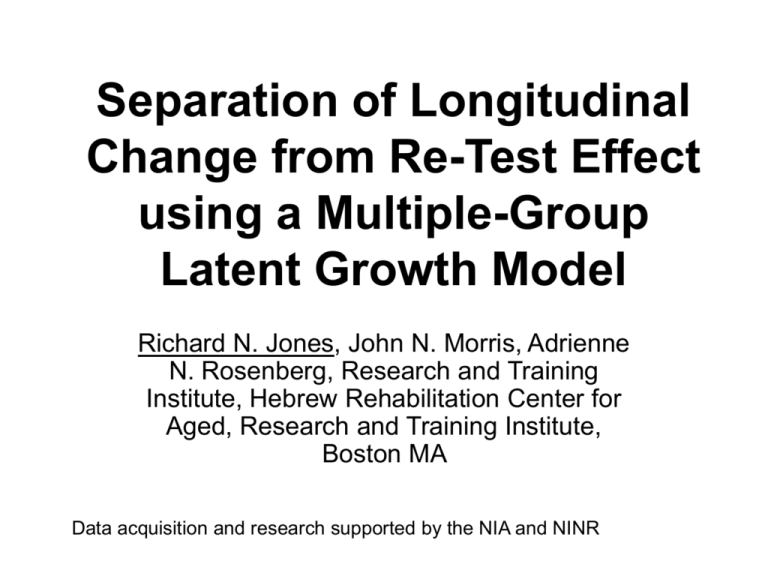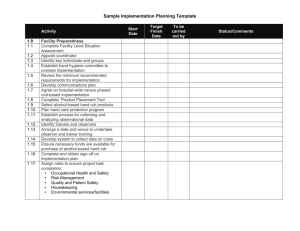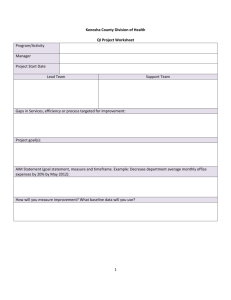Separation of Longitudinal Change from Re
advertisement

Separation of Longitudinal Change from Re-Test Effect using a Multiple-Group Latent Growth Model Richard N. Jones, John N. Morris, Adrienne N. Rosenberg, Research and Training Institute, Hebrew Rehabilitation Center for Aged, Research and Training Institute, Boston MA Data acquisition and research supported by the NIA and NINR Objective • Describe a commonly occurring challenge in longitudinal studies of cognitive aging: the re-test effect • Present a general latent variable modeling framework for statistically separating aging and re-test effects • Demonstrate the modeling approach in real data (ACTIVE Cognitive intervention study) Hypothesized Longitudinal Course 50 45 40 35 30 0 1 2 Time 3 Hypothesized and Observed Longitudinal Course 55 50 45 40 35 30 0 1 2 Time 3 Bias in Estimate of Baseline Level and Change 55 50 45 40 35 30 0 1 2 Time 3 Hypothesized Longitudinal Course 55 Retest + Aging Effect Performance 50 Aging + Residual Retest 45 40 35 30 0 1 2 Time 3 Latent Growth Model Performance 50 45 40 35 30 0 1 2 Time yij 1i 2i TIMEi ij 1i 1 1i 2i 2 2i 3 1 2 3 4 y1 y2 y3 y4 Latent Growth Curve Model for Linear Change 1 2 3 4 * * * * y1 y2 y3 y4 [0] 1 * 1 [0] 1 1 1 2 3 [1=*] [0] [0] * [2=*] * Hypothesized Longitudinal Course 55 Performance 50 45 40 35 30 0 1 2 3 Time yij 1i 2i TIMEi 3i RETESTi ij 1i 1 1i 2i 2 2i 3i 3 3 i 1 2 3 4 y1 y2 y3 y4 Latent Growth Curve Model for Linear Change with second intercept (learning factor) [3=*] ? 1 1 1 1 2 3 4 * * * * y1 y2 y3 y4 [0] 1 * 1 [0] 1 1 1 2 3 [1=*] [0] [0] * [2=*] * Adding Background and Explanatory Variables yij 1i 2i TIMEi 3i RETESTi ij 1i 1 iq xq 1i 2i 2 iq xq 2i 3i 3 iq xq 3i 1 2 3 4 y1 y2 y3 y4 x x x Background Variables Example: ACTIVE • Advanced Cognitive Training for Vital and Independent Elderly • Six sites (AL, IN, MA, MI, MD, PA) • Random assignment to one of four intervention arms, 4-group pre-post design – Speed of Processing, Memory, Logical Reasoning, No Training Control • Healthy older adults (n=2,428) aged 65-83 Outcome Measure • Speed of Processing Composite – Ball, et al. Jama, 2002; 288:2271-81. – Regression-method factor score for multiple speeded tests – Based on minimum stimulus duration at which participants could identify and localize information with 75% accuracy, under different cognitive demand conditions – Lower is better (faster speed of processing) 150 100 50 0 -5 0 5 Speed of Processing Composite Measurement Schedule Assessment Study Year Baseline 0 (intervention) Post-Test 0.23 Follow-up 1 1.00 Follow-up 2 2.00 Speed as a Function of Age (Baseline only, All Participants) 2 1 0 -1 -2 65 75 Age 85 Conflicting Estimates of Change Model Estimated Annual Change Baseline age-diff. Repeated Measures† Post-Test Part FU1 -> FU2 † speed-trained subjects excluded +0.19 -3.80 -0.01 Multiple Group LGM • Use age as a cohort indicator • Model change as a function of age rather than study time • Assume (initially) no cohort differences in – growth – re-test effects, and the – influence of background variables Cross-Sequential Cohort Design Year of Obs '95 '96 '97 Observation 1 2 3 -----------------------Cohort Age 1 65 66 67 2 66 67 68 3 67 68 69 Hypothesized and Observed Longitudinal Course 60 50 40 30 20 hypothesized observed 10 65 66 67 Age 68 69 Mean Scores On Repeat Testing (Non-Speed Trained Group) 2 1 0 -1 -2 0 1 2 Study Year GEE model using ordinal time adjustment for baseline age Parameterization of Multiple Group LGM 1 baseline 12-week post-test 2 (aget ) year 1 follow-up 3 (aget ) (aget ) y1 y2 y3 1 (4) [ 1](1) year 2 follow-up 4 (aget ) y4 1 1 1 0.23 * * * * [ 2](2) [ 3](3) NOTE: "Age" is age at baseline assessment. non-Speed trained subjects only. Model relevant to Parameterization of Multiple Group LGM = y1 y2 y3 y4 1 2 3 1 age-65 0 1 age-65 0.23 1 age-64 0.23 1 age-63 0.23 where yt (t=1,2,3,4) refer to speed composite scores at baseline, 12-week post-test, 1-year follow-up and 2-year follow-up, and age is age at baseline assessment. Parameterization of Multiple Group LGM = y1 y2 y3 y4 1 2 3 1 age-65 0 1 age-65 0.23 1 age-64 * 1 age-63 * where yt (t=1,2,3,4) refer to speed composite scores at baseline, 12-week post-test, 1-year follow-up and 2-year follow-up, and age is age at baseline assessment. Model 1: Maximum Likelihood Estimation, Complete Sample Analysis Assuming MAR; Excluding those who received speed training (4 y’s, 3 ’s) N=1,801; Number of groups = 19 (n=31 to 131) Model 2(df), P 277.353 (218) P=.004 CFI, TFI 0.985, 0.992 RMSEA (90% CI) 0.054 (.032-.072) Model Part Estimate SE P Time Steps for Recall Effect post-test 0.23 --first annual follow-up 0.28 (.01) <.001 second annual follow-up 0.34 (.02) <.001 Latent Variable Means/Intercepts Baseline -1.83 (0.10) <.001 Age-related change +0.18 (0.01) <.001 Retest effect -3.01 (0.22) <.001 Regressions Re-test effect on Baseline 0.44 (0.07) <.001 Age-related change on Baseline -0.01 (0.00) <.001 Model 2: ...adding educational attainment (years of education centered at grade 12) to model Model 2(df), P 335.963 (291) P=.04 CFI, TFI 0.976, 0.984 RMSEA (90% CI) 0.057 (.016-.083) Model Part Estimate SE P Time Steps for Recall Effect post-test 0.23 --first annual follow-up 0.29 (.02) <.001 second annual follow-up 0.33 (.02) <.001 Latent Variable Means/Intercepts Baseline -1.50 (0.15) <.001 Age-related change +0.18 (0.02) <.001 Retest effect -2.88 (0.32) <.001 Regressions Re-test effect on Baseline Age-related change on Baseline Baseline on years of education Re-test on years of education Age-related change on education 0.51 -0.01 -0.19 0.02 0.00 (0.12) (0.01) (0.05) (0.07) (0.00) <.001 0.061 <.001 0.766 0.394 Results: Cohort-Specific and Model Implied Trajectories Speed compsite (SD units marked) 2 0 -2 -4 65 70 75 80 age Model-Implied Age-Related Change Observed Cohort-Specific Trajectories Age differences (baseline) 85 Hypothesized Longitudinal Course 55 Retest + Aging Effect Performance 50 Aging + Residual Retest 45 40 35 30 0 1 2 Time 3 Conclusion • MGLGM one method for modeling re-test effect and aging effect separately • LGM feature of “freely estimating time scores” useful for capturing “residual” retest effects • Examine relationship of background characteristics and variance in retest and aging effects • Relationship of retest and learning to clinically meaningful outcomes Acknowledgement • • • ACTIVE study (Advanced Cognitive Training for Independent and Vital Elderly) is a multi-site collaborative cognitive intervention trial supported by the National Institute on Aging and the National Institute on Nursing Research. Sharon Tennstedt is the principal investigator at the coordinating center, New England Research Institutes, Watertown, Massachusetts (AG14282). The principal investigators and field sites include – Karlene Ball, University of Alabama at Birmingham (AG14289); – Michael Marsiske, Institute on Aging, University of Florida, Gainesville (AG14276); – John Morris, Hebrew Rehabilitation Center for Aged Research and Training Institute, Boston (NR04507); – George Rebok, Johns Hopkins University Bloomberg School of Public Health (AG14260); – Sherry Willis, Penn State University, Gerontology Center (AG14263). – David Smith was the principal investigator at Indiana University School of Medicine, Regenstrief Institute, Indianapolis (NR04508) at the time of initial award, currently Fred Unverzagt is currently the principal investigator. Age Differences in MSQ Score (Baseline EPESE) 5.10 5.00 4.90 4.80 4.70 b = -.02 SD units per year 4.60 65 70 75 80 85 Age Baseline data from EPESE/ICPSR public use data file, baseline data only, listwise complete on Mental Status Questionnaire (MSQ) scores at first, fourth and seventh assessment Age Differences in MSQ Score (Baseline EPESE) 5.1 b = -0.02 SD/year 4.9 b = -0.10 SD/year b = -0.06 SD/year 4.7 4.5 0 3 6 Study Year Baseline data from EPESE/ICPSR public use data file, baseline data only, listwise complete on Mental Status Questionnaire (MSQ) scores at first, fourth and seventh assessment






